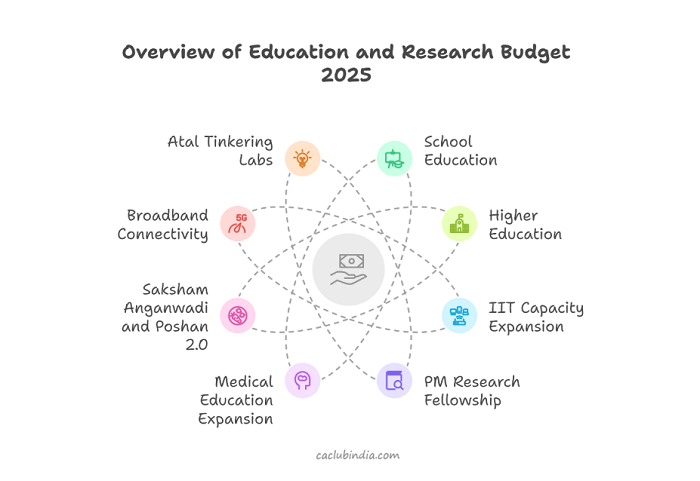The Budget 2025 demonstrates the Indian government's strategic commitment to enhancing the education sector, emphasizing critical areas such as digital learning, skill development, and artificial intelligence (AI) integration. The Ministry of Education's budget allocation has seen a notable increase from ₹1,20,628 crore in the previous fiscal year (2024-25) to ₹1,28,650 crore for the year 2025-26, reflecting a growth rate of 6.65%.
We examine the important allocations and initiatives outlined in India’s 2025 Budget for the education sector. The main highlights are:

Budgetary Allocation – School Education
The budget allocation for school education has risen from ₹73,008 crore to ₹78,572 crore, reflecting a 7.62% increase. For FY 2025-26, the Department of School Education & Literacy has received its highest-ever budget allocation of ₹78,572 crore.
The government plans to establish 50,000 Atal Tinkering Labs in government schools to cultivate curiosity and innovation among students.
Flagship programs have seen an increase in their Budget Allocation (BE) for FY 2024-25, including Samagra Shiksha, PM-POSHAN, and PM-SHRI.

Budgetary Allocation – Higher Education
The Department of Higher Education has received an allocation of ₹50,078 crore, which encompasses ₹6,991 crore designated for various schemes
For the 2025-26 financial year, the budget for the Higher Education Department has risen to ₹50,077.95 crore, up from ₹47,619.77 crore in FY 2024-25.
The University Grants Commission (UGC) has seen its funding rise by 33.44%, totalling₹3,335.97 crores.
The Indian Institutes of Technology (IITs) have received an allocation of ₹11,349 crore, a 9.92% increase from the previous year. Five IITs' infrastructure will be enhanced to support an additional 6,500 students.
The National Institutes of Technology (NITs) have also received a 12.85% budget increase, bringing their total allocation to ₹5,687.47 crore.
Expansion of Capacity in IITs
The Budget for 2025 aims to enhance infrastructure and create more opportunities within the Indian Institutes of Technology (IITs).
The government intends to enhance infrastructure at five IITs founded after 2014 in order to accommodate an additional 6,500 students. This development will include the construction of hostels and academic facilities.
The initiative seeks to enhance access to high-quality education for aspiring engineers, particularly those from underrepresented areas. Over the last decade, the total student population in 23 IITs has doubled, rising from 65,000 to 135,000.
Five national centres of excellence dedicated to skilling will be established, leveraging global expertise and collaborations. These partnerships will encompass curriculum development, trainer training, skill certification programs, and regular evaluations.
PM Research Fellowship
The Prime Minister's Research Fellowship (PMRF) initiative aids exceptional students engaged in doctoral research in India. The Budget for 2025 has significantly enhanced the PMRF scheme by introducing 10,000 additional fellowships over the next five years.
The PMRF scheme has been broadened to encompass eligible students from all accredited institutions and universities across India. Candidates must be pursuing a PhD at one of the PMRF-granting institutions and should have spent no more than 12 months in their PhD program.
The PMRF offers appealing financial assistance to chosen scholars enrolled in PhD programs at IITs, IISc, and IISERs.
PMRF Granting institutes submit nominations for eligible candidates to the National Coordinating Institute via the PMRF portal. Once nominated, candidates can complete a detailed application through the official portal.
Expansion of Medical Education
Budget 2025 highlights the need to expand medical education in India, aiming to tackle the shortage of healthcare professionals and improve the overall healthcare system.
The government plans to introduce 10,000 new medical seats in the coming year, contributing to a larger objective of expanding capacity by 75,000 seats over the next five years.
In the past decade, the number of medical colleges in the country has nearly doubled, increasing from 387 in the 2013-14 academic year to 766 in 2024-25. This total comprises 423 government-run colleges and 343 private institutions.
The increase in MBBS seats and medical colleges promotes a more equitable distribution of medical education opportunities, allowing students from rural regions to gain improved access to high-quality education.
The Saksham Anganwadi and Poshan 2.0 Program
Saksham Anganwadi and Poshan 2.0 is a comprehensive nutrition support initiative in India aimed at tackling malnutrition issues among children, adolescent girls, pregnant women, and lactating mothers. The program focuses on enhancing the quality and accessibility of nutrition, creating an environment that encourages health, well-being, and immunity.
In 2021-22, the Government of India revamped the Integrated Child Development Services (ICDS) and POSHAN Abhiyaan into a unified program called Saksham Anganwadi and POSHAN 2.0. This initiative integrates Anganwadi Services, POSHAN Abhiyaan, and the Scheme for Adolescent Girls.
The program is executed by State Governments and Union Territory administrations, with funding shared between the Central Government and the states. To ensure effective monitoring, the 'Poshan Tracker'—a centralized ICT data system connected to the RCH Portal (Anmol) of the Ministry of Health and Family Welfare—is utilized. This scheme is available to all eligible beneficiaries who are registered at their nearest Anganwadi centre and possess Aadhaar identification.
The program is designed to support children aged 0-6 years, pregnant women, lactating mothers, and adolescent girls aged 14-18. States are responsible for identifying adolescent girls within the 14-18 age range.
Broadband Connectivity to Government Secondary Schools and PHCs
The Union Budget for 2025-26 highlights the importance of strengthening digital infrastructure by ensuring broadband connectivity for all government secondary schools and Primary Healthcare Centres (PHCs) in rural regions. This initiative will be implemented through the BharatNet project, for which the government has allocated ₹22,000 crore—an impressive 238% increase compared to last year's budget.
The BharatNet project is designed to deliver high-speed, affordable internet access to all gram panchayats (village blocks) across the country, thereby closing the digital divide and promoting inclusive growth.
This initiative seeks to provide crucial services such as e-health, e-education, and e-governance to rural and remote areas via telecom operators. It will facilitate smooth connectivity for government entities and professionals, making governance more efficient and accessible to the general public.
Atal Tinkering Labs
Atal Tinkering Labs (ATL) are specialized workspaces set up in Indian schools as part of the Atal Innovation Mission (AIM) by NITI Aayog, Government of India. This initiative aims to "nurture one million children in India as innovative thinkers." The primary goal is to encourage curiosity, creativity, and imagination among young learners while equipping them with essential skills such as design thinking, computational thinking, adaptive learning, and physical computing.
ATL is a space where young thinkers can develop their ideas through practical activities and acquire skills in innovation.
ATL organizes a variety of activities that include regional and national competitions, exhibitions, workshops focused on problem-solving, product design and fabrication, as well as lecture series.
The scheme provides a grant-in-aid of up to ₹20 lakh to chosen schools for establishing ATL. Out of this amount, ₹10 lakh is allocated for capital expenditures, while the other ₹10 lakh is designated for operational and maintenance costs.
Allocations for education and research are expected to be in line with wider national development objectives, including economic growth, innovation, and social equity. To ensure that the funds distributed meet their intended objectives, effective implementation and accountability systems will be essential. Governments may also engage stakeholders, such as educators, researchers, and the public, to help shape budget priorities.






 CAclubindia
CAclubindia
